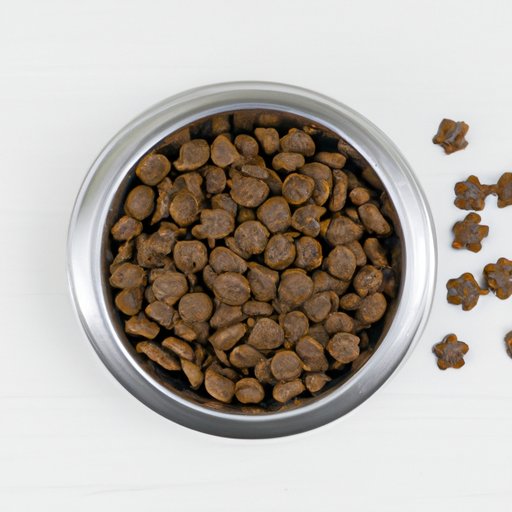
I. Introduction
Cats are playful and lovable pets, but they can also be prone to overeating. Overfeeding your cat can lead to serious health problems, such as obesity and diabetes. It is essential to understand your cat’s nutritional needs and establish healthy habits for feeding them. In this article, we will discuss how much you should feed your cat to keep them healthy and happy.
II. A Guide to Feeding Your Feline Friend: Understanding Your Cat’s Nutritional Needs
Cats are obligate carnivores, which means they require a high-protein diet to thrive. A well-balanced diet should contain protein, fat, and carbohydrates in the right proportions. The nutritional requirements for cats include:
- Protein: Cats require a minimum of 26% protein in their diet.
- Fat: Cats need a higher fat content than dogs, with a minimum of 9% of their diet consisting of fat.
- Carbohydrates: Cats do not require carbohydrates in their diet, but a small amount can be beneficial.
- Vitamins and minerals: Cats need a variety of vitamins and minerals, including vitamins A, E, D, and B, as well as calcium, phosphorus, and magnesium.
You have a choice when it comes to what type of food you feed your cat. Dry food is convenient and can be left out for your cat to munch on throughout the day. Wet food provides more moisture and protein, which can help with hydration and digestion. Combining the two can offer the best of both worlds.
Many pet owners wonder if homemade cat food is a good option. While homemade food can be a healthy option, it is essential to ensure your cat is getting all the necessary nutrients. Consulting with a veterinarian or a qualified pet nutritionist is a good idea before deciding to make homemade cat food.
III. The Dos and Don’ts of Feeding Your Cat: Avoiding Common Mistakes
Overfeeding and underfeeding are two common mistakes pet owners make when feeding their cats. Cats should be fed in moderation to avoid obesity, which can lead to serious health problems. Foods to avoid giving to cats include:
- Dairy: Most cats are lactose intolerant and cannot digest dairy products properly.
- Raw meat: Raw meat can contain harmful bacteria and parasites that can make cats sick.
- Onions and garlic: These contain compounds that can damage your cat’s red blood cells.
- Tuna: While tuna is okay in moderation, too much tuna can lead to mercury poisoning.
Another common mistake is feeding your cat dog food. Cats have different nutritional requirements than dogs, and feeding them dog food can result in deficiencies in vital nutrients that are essential for their health.
IV. Small Portions, Big Benefits: The Importance of Portion Control for Your Cat’s Health
Portion control is crucial when it comes to feeding cats. Overfeeding can lead to obesity, which can cause several health problems, such as high blood pressure and diabetes. The amount you should feed your cat depends on their weight and activity level. A general guideline is to feed 20-30 calories per pound of body weight. If your cat is less active, feed them closer to 20 calories per pound. For a more active cat, they can eat up to 30 calories per pound.
It is essential to measure your cat’s food accurately to ensure they are getting the right amount. Using a measuring cup is an effective way to manage portion sizes. Consistent feeding schedules are also essential for maintaining a healthy weight in your cat.
V. Balanced Meals for a Healthy Cat: Tips for Creating a Nutrient-Rich Diet
A balanced diet for cats should include both animal-based proteins and plant-based proteins. Animal-based proteins include meat and fish, while plant-based proteins include grains and legumes. It is essential to introduce new foods gradually to your cat to avoid a digestive upset. Treats should also be fed in moderation and not disrupt the balance of your cat’s diet.
VI. How to Tell if Your Cat is Overweight: Signs to Look Out For
Obesity is a significant problem in cats and can lead to several health problems. Signs of obesity in cats include:
- Difficulty jumping or climbing stairs
- Gasping for breath
- Lethargy
- Increased sleeping
- Belly hangs down
Cats that are obese are at a higher risk of developing health conditions such as heart disease and diabetes.
VII. Measuring Out Your Cat’s Meals: The Importance of Accurate Portions
The importance of measuring your cat’s food cannot be overstated. The difference between a healthy weight and obesity can be as little as a few extra kibbles a day. Measuring cups can help you manage portion sizes and ensure your cat is getting the right amount of food. Feeding your cat on a regular schedule can also help maintain their weight.
VIII. Finding the Right Balance: Determining the Ideal Type and Amount of Food for Your Cat’s Age and Activity Level
As cats age, their nutritional needs change. Kittens require more protein and fat to support their growth and development, while senior cats require fewer calories to maintain their weight. Adjusting your cat’s diet based on their age and activity level is essential for maintaining a healthy weight. Consulting a veterinarian for dietary guidance is a good idea, especially if your cat has any health conditions.
IX. Conclusion
Feeding your cat a balanced diet with appropriate portions is essential for their health and well-being. Understanding your cat’s nutritional needs, avoiding common mistakes, and measuring their food accurately can help you maintain a healthy weight for your feline friend. By following these tips and consulting with your veterinarian, you can help ensure your cat lives a happy and healthy life.





